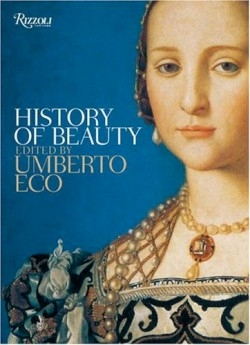The History of Beauty
“We shall review those things that, over thousands of years, human beings have considered beautiful,” proposes the author in his introduction to this book, on which he collaborated with Girolamo de Michele. This is no quest, however, to identify similarities between various concepts of beauty. Rather, Eco and de Michele attempt to highlight the differences, leaving it to the reader to “seek any unity underlying those differences.”
Eco, the acclaimed author of The Name of the Rose and Foucault’s Pendulum, is also president of the Scuola Superiore di Stadi Umanistici, University of Bologna, and is respected by scholars for his essays as much as for his works of fiction. That he should take on so vast and unwieldy a topic as a history of beauty may not surprise those already familiar with his intellectual curiosity and his bent for writing wisely about subjects considered too romantically vague to pin down on paper. De Michele, though less well known to the English-speaking world, has also written extensively on philosophical subjects.
The authors document their history of beauty with works of art ranging from the thirtieth millennium BC to the present; they chose to use art to exemplify beauty because “it was artists, poets and novelists who told us about the things they considered beautiful…and left us examples.” In fact, the reliance on art transforms this book from a series of well-written philosophical musings to a compelling, visually appealing invitation to ponder human ideals of loveliness through the ages. Nearly every page boasts a glorious color plate of some renowned work of art or design, along with excerpts from writers of each time period.
Most helpful may be the comparative tables at the beginning, which are divided into a range of archetypal categories. Thus the reader sees thirty examples of the naked female figure in the “Nude Venus” table; seventeen images of naked male figures in the “Nude Adonis” table; and so on, through “Clothed Venus,” “Clothed Adonis,” “Face and Hair of Venus,” “Face and Hair of Adonis,” “Madonna,” “Jesus,” “Kings,” “Queens,” and “Proportions.” Although such constructions are obviously subjective, they serve to illuminate the authors’ point. As one proceeds in chronological order through the images in a given category, one sees where imitation has occurred, and also notes the numerous divergences in style and emphasis. The faces of men in the “Adonis” category—bearded and clean-shaven, smiling and somber—represent men of many different races, and some have faces that would not be considered handsome today. Others, like Michelangelo’s David, have represented manly beauty for centuries. These tables encourage thought-provoking comparison.
The authors go on to cover both the expected, like “The Aesthetic Ideal in Ancient Greece,” and the unexpected, like “Ugliness as a Requirement for Beauty.” They explain that while ugliness has often been portrayed as the antithesis of beauty, it also came to be a necessary part of the universal equilibrium that permits beauty to occur. The authors then trace the increasing acceptance of hideous figures in art. In another intriguing discussion, they examine the development of “the beautiful machine.” Truly delightful facts are uncovered, like the fact that James Watt tried to hide the unpleasing functionality of his steam engine invention beneath a façade built like a small Classical temple.
At last, Eco and De Michele arrive at today’s concepts of beauty—and here, they say, there is no specific, recognizable ideal, as there was for so many eras in the past. Instead, they point to the ceaseless recycling of earlier, conflicting forms of beauty, and the mass acceptance of them all as “beautiful.” A hypothetical explorer from the future, they declare, “will have to surrender before the orgy of tolerance, the total syncretism and the absolute and unstoppable polytheism of Beauty.”
This may not be the condemnation it appears to be. Eco and de Michele are not out to convert anyone. They are not salesmen hawking a particular brand of beauty. Rather, they are like exceptionally well-informed museum guides, steering their readers down a sometimes bewildering series of corridors as they point out notable works. They may mention connections between one statue and another, or discuss the relationship between different portraits. For the most part, however, they provide their readers the tools they need to think about beauty, and leave them to draw their own conclusions. Such encouragement to speculate independently is another aspect of the “tolerance” that has led to today’s diffuse notions of beauty.
Disclosure: This article is not an endorsement, but a review. The publisher of this book provided free copies of the book to have their book reviewed by a professional reviewer. No fee was paid by the publisher for this review. Foreword Reviews only recommends books that we love. Foreword Magazine, Inc. is disclosing this in accordance with the Federal Trade Commission’s 16 CFR, Part 255.

